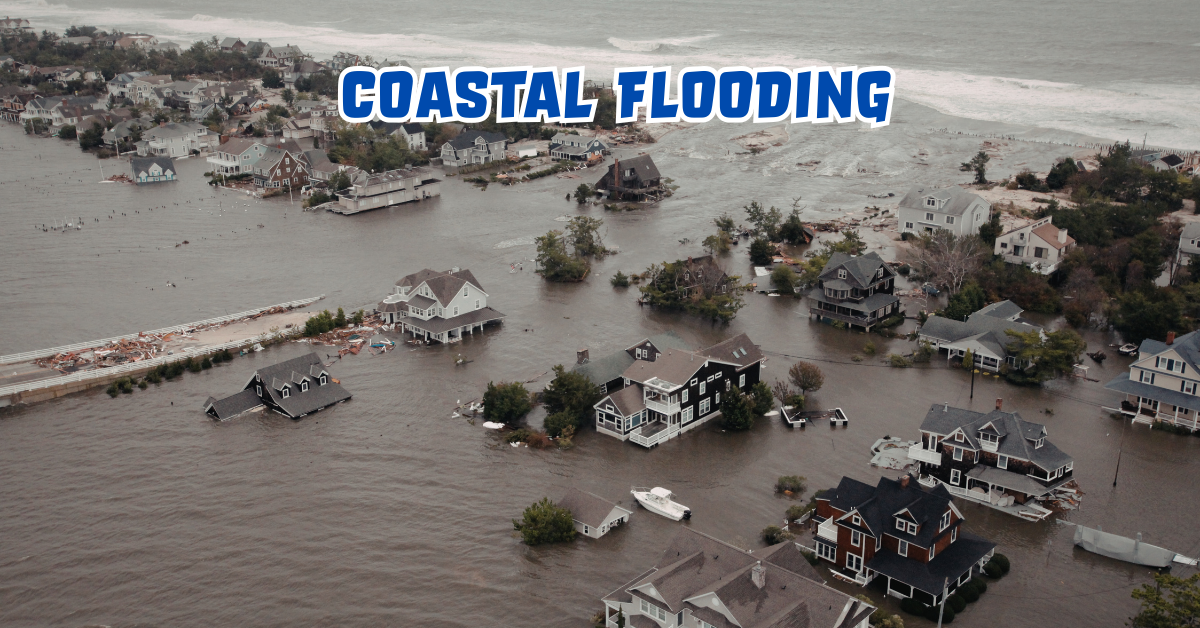Coastal flooding has moved from being a rare natural event to one of the most pressing global challenges of our century. In the first hundred words, the essence is clear: coastal flooding refers to the inundation of normally dry, low-lying coastal areas by seawater, caused primarily by rising sea levels, intense storms, and human-driven coastal modifications. It is not just about the water that seeps into streets; it’s about the loss of land, the displacement of communities, the collapse of infrastructure, and the slow, creeping transformation of our planet’s most dynamic ecosystems. From New York to Jakarta, the rising tides are rewriting geography, redefining economics, and reshaping the boundaries of human habitation.
The United Nations warns that by 2050, nearly 800 million people could face the direct consequences of coastal flooding. The issue transcends geography—it affects agriculture, trade, public health, and cultural heritage. Once considered occasional disasters, storm surges and high tides have become annual, even seasonal, phenomena for millions. The conversation has shifted from prevention to adaptation, from denial to resilience. Coastal flooding is no longer tomorrow’s problem; it is the water at our doorstep today.
The Anatomy of Coastal Flooding
Coastal flooding occurs when ocean waters push inland, overwhelming barriers and drainage systems. There are several key drivers behind this phenomenon. First, sea-level rise, largely fueled by melting polar ice caps and the thermal expansion of seawater, has elevated the baseline for tides and storm surges. Second, storm surges—temporary rises in sea level due to atmospheric pressure changes and wind—amplify flooding during hurricanes or cyclones. Third, land subsidence, often a result of groundwater extraction or natural geological shifts, lowers the elevation of coastal regions, making them more vulnerable to even modest sea-level increases.
To understand the relationship between human activity and coastal flooding, scientists often point to urbanization patterns. Coastal cities are expanding rapidly, with dense populations and concrete surfaces that prevent natural absorption of excess water. As mangroves and wetlands—nature’s protective barriers—are cleared for development, natural flood defenses weaken. The result is a compound crisis where nature’s balance and human ambition collide, producing both immediate devastation and long-term instability.
Table 1: Major Drivers of Coastal Flooding
| Driver | Description | Impact on Coastal Areas |
|---|---|---|
| Sea-Level Rise | Increase in ocean levels due to melting ice and thermal expansion. | Permanent inundation of low-lying areas and loss of land. |
| Storm Surges | Temporary sea-level increases caused by storms. | Sudden flooding, erosion, and infrastructure damage. |
| Land Subsidence | Sinking of ground due to human or natural causes. | Lowers coastal elevation, increasing flood risk. |
| Urban Development | Expansion of impermeable surfaces in cities. | Reduces water drainage capacity and worsens flood impacts. |
| Wetland Loss | Destruction of natural buffers like mangroves. | Removes natural flood protection, increasing vulnerability. |
The Human Footprint on Coastal Vulnerability
While climate change amplifies natural risks, human choices often magnify their effects. Urban sprawl, deforestation of coastal forests, and poor land management are major accelerators of flood vulnerability. Many developing nations, drawn by trade access and tourism, have built cities right along coastlines without long-term resilience planning. This pattern is particularly evident in South and Southeast Asia, where megacities like Dhaka, Mumbai, and Manila sit perilously close to rising tides.
Poorly planned infrastructure compounds the issue. Roads, ports, and housing developments block natural drainage routes, while inadequate waste management clogs waterways. When heavy rainfall coincides with high tides, even minor weather events turn catastrophic. The tragedy is that many of these floods are predictable, yet political and economic inertia often delays meaningful intervention.
The irony lies in how prosperity is both a cause and casualty of coastal flooding. Wealth attracts urbanization, urbanization attracts construction, and construction attracts vulnerability. As one climate expert put it, “We are building our wealth at the edge of the water, and the water is claiming its debt.”
Economic Impacts: When Floods Drown Economies
The economic toll of coastal flooding is staggering. The World Bank estimates annual losses exceeding $1 trillion globally by 2050 if adaptation measures lag. These losses come not just from damaged infrastructure but also from disrupted trade, lost productivity, and reduced tourism. Coastal industries—especially ports, fisheries, and refineries—face existential threats as waters encroach on critical assets.
Small island nations like the Maldives and Tuvalu are on the front lines. Their economies rely heavily on tourism and fishing, both of which are at risk. Even advanced economies are not immune; New York’s subway system, for example, suffered billions in damages after Hurricane Sandy in 2012. The cost of rebuilding and fortifying cities against future floods has become a permanent line in many national budgets.
The ripple effects extend beyond direct costs. Insurance companies, faced with escalating claims, are retreating from high-risk zones. Property values in flood-prone areas are declining, creating what experts call “climate redlining.” This economic stratification is forcing the most vulnerable—often low-income residents—to bear the heaviest burdens of a crisis they contributed least to creating.
Environmental Consequences: When Ecosystems Drown
Beyond human economies, nature itself faces severe consequences. Coastal flooding alters salinity levels in estuaries, destroys mangrove ecosystems, and erodes coral reefs. These habitats, which sustain diverse marine life and buffer coastlines from waves, are being pushed beyond recovery. The result is a cascading collapse of biodiversity and food chains.
Rising water levels also contaminate freshwater aquifers with saltwater intrusion, reducing access to drinkable water for millions. Agricultural lands, once fertile, turn saline and unproductive. As one marine biologist remarked, “Coastal flooding isn’t just swallowing land—it’s rewriting the chemistry of life itself.”
The loss of wetlands is particularly alarming. Wetlands absorb floodwaters and filter pollutants, serving as natural guardians of coastal stability. Their destruction accelerates both ecological and human vulnerability. Environmental economists now argue that restoring wetlands yields greater long-term benefits than constructing expensive seawalls.
Table 2: Environmental and Economic Impacts of Coastal Flooding
| Category | Effect | Long-Term Consequences |
|---|---|---|
| Agriculture | Soil salinization and crop failure. | Food insecurity and loss of livelihoods. |
| Freshwater Systems | Saltwater intrusion into aquifers. | Decline in drinking water availability. |
| Marine Ecosystems | Destruction of coral reefs and mangroves. | Loss of biodiversity and fish populations. |
| Infrastructure | Damage to roads, ports, and utilities. | Increased maintenance and reconstruction costs. |
| Real Estate | Declining property values. | Displacement and financial instability. |
Social Dimensions: The Human Cost of Rising Waters
The social repercussions of coastal flooding reach far beyond physical damage. Displacement has emerged as one of the most visible outcomes, giving rise to a new term: climate refugees. Entire communities are relocating inland as their ancestral homes become uninhabitable. This forced migration strains urban resources, fuels inequality, and ignites political tension.
In nations like Bangladesh, residents experience multiple displacements—first by floods, then by land scarcity in resettlement zones. The psychological toll is profound. Studies show increased rates of anxiety, depression, and post-traumatic stress among flood survivors. The cultural loss is equally devastating: centuries-old fishing traditions, architecture, and community bonds vanish beneath the tides.
Education and healthcare also suffer. Schools close for extended periods, and disease outbreaks—cholera, dengue, malaria—often follow flooding. In the words of a humanitarian worker in Jakarta, “Coastal flooding doesn’t just take homes—it erodes hope.”
Urban Adaptation: Building Resilience for the Future
The growing awareness of coastal flooding has driven innovation in urban planning. Cities around the world are reimagining their relationship with water. Rotterdam, for instance, has transformed itself into a model of climate resilience with floating architecture, water plazas, and adaptive dike systems. Singapore is investing heavily in desalination and rainwater harvesting to secure water independence.
New York’s post-Sandy strategy includes elevated parks, reinforced seawalls, and green infrastructure designed to absorb excess water naturally. However, adaptation is not a one-size-fits-all solution. In some regions, managed retreat—strategically moving communities away from vulnerable areas—is becoming the only viable option.
Technology plays a crucial role in modern adaptation. Satellite-based flood forecasting, AI-driven urban modeling, and nature-based engineering are helping cities anticipate and mitigate flood impacts. Yet, these innovations require political will, global cooperation, and equitable funding. Without inclusivity, adaptation risks becoming another form of privilege.
Policy, Governance, and International Collaboration
Effective management of coastal flooding demands coordination across borders and sectors. Governments must balance short-term economic gains with long-term sustainability. Policies that integrate climate data into zoning laws, infrastructure design, and disaster preparedness are essential.
The Paris Agreement and subsequent climate accords emphasize global responsibility, but implementation remains uneven. Wealthy nations, responsible for most historical emissions, face moral and financial obligations to support vulnerable countries through funding and technology transfer.
Local governance also plays a critical role. Empowering communities to participate in resilience planning ensures that adaptation measures reflect local realities. In many regions, community-led mangrove restoration and flood-resilient agriculture are proving more sustainable than top-down engineering projects.
The Science of Prediction: Forecasting Future Floods
Modern science offers increasingly accurate models of how sea-level rise will reshape coastlines. Using satellite data and geospatial analytics, researchers can project flood risks decades ahead. These models consider factors like land elevation, rainfall intensity, and infrastructure vulnerability.
However, prediction alone is not prevention. Many policymakers struggle to translate data into action. Part of the challenge lies in communicating scientific uncertainty without undermining urgency. Scientists often note that uncertainty cuts both ways—flood impacts could be even worse than models suggest if emissions continue unchecked.
The coming decades will test the limits of prediction and preparedness. Whether humanity learns to live with water or continues to fight it will determine the contours of future civilization.
Looking Ahead: A New Relationship with the Sea
Coastal flooding is, at its core, a story of coexistence. Humans have always been drawn to the sea for sustenance, trade, and beauty. But as the balance shifts, survival may depend on humility—accepting that we can no longer control nature, only adapt to it.
Architects, economists, scientists, and citizens must converge on a shared goal: resilience. That means restoring wetlands instead of reclaiming them, elevating homes instead of rebuilding on the same vulnerable plots, and teaching future generations to respect the rhythms of the sea.
As one urban planner in Copenhagen summarized, “The future city is not a fortress against water—it is a partnership with it.”
Conclusion: The Tides of Responsibility
Coastal flooding is no longer a distant threat; it is a defining reality of the Anthropocene. The crisis intertwines science, policy, and morality, challenging humanity to reconcile its ambitions with ecological boundaries. The solutions—resilient infrastructure, restored ecosystems, informed governance—are within reach but require courage and cooperation.
History will judge not by the floods we endured, but by how we responded. The rising sea is a mirror reflecting our collective choices. Whether it drowns our progress or reshapes it into a more sustainable civilization depends on what we do now.
FAQs
1. What causes coastal flooding?
Coastal flooding is primarily caused by sea-level rise, storm surges, and land subsidence. Human activities such as coastal development and wetland destruction intensify its impacts.
2. Which areas are most at risk?
Low-lying coastal cities and island nations, including parts of Bangladesh, the Philippines, and Florida, face the greatest risks due to elevation and exposure.
3. How does climate change contribute?
Climate change accelerates polar ice melt and thermal expansion of oceans, leading to higher sea levels and more intense weather events.
4. Can coastal flooding be prevented?
While prevention is limited, its impacts can be mitigated through resilient urban design, natural barriers, and global emission reduction.
5. What is the long-term outlook?
If current trends continue, many coastal regions may become uninhabitable by the end of the century, making adaptation crucial for survival.











